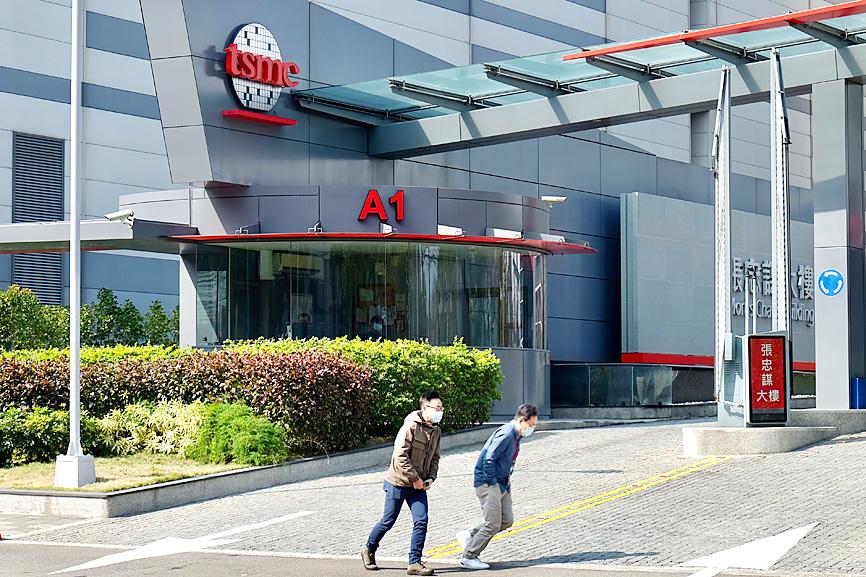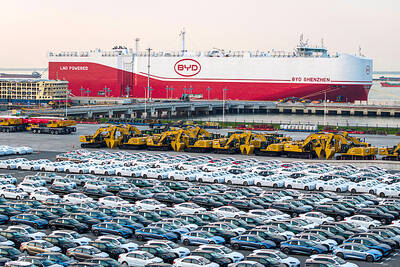The EU is considering building an advanced semiconductor factory in Europe in an attempt to avoid relying on the US and Asia for technology at the heart of some of its major industries.
The EU is exploring how to produce semiconductors with features smaller than 10 nanometers, and eventually down to 2-nanometer chips, according to people familiar with the project. The aim is to curtail dependence on countries such as Taiwan for chips to power 5G wireless systems, connected cars, high-performance computing and more.
Taiwan Semiconductor Manufacturing Co (TSMC, 台積電) and Samsung Electronics Co of South Korea, the two leaders making the most innovative processors in the sector, could be involved in the EU project, but nothing has been decided, a French Finance Ministry official said in a press briefing on Thursday, following the report from Bloomberg.

Photo: Sam Yeh / AFP
European attempts to ramp up production — led in part by European Industry Commissioner Thierry Breton — could involve redeveloping an existing foundry or building a new one, the people said, adding that no final decision has been taken and the time frame of the project is still to be determined.
“When it comes to fab location selection, we need to consider many factors including customers’ need. TSMC does not rule out any possibility, but there is no concrete plan at this time,” TSMC spokeswoman Nina Kao (高孟華) said in an e-mail when asked about cooperating with Europe.
Once a hub of semiconductor factories, Europe has dramatically cut back on manufacturing over the past 20 years, with automotive-chip designers including NXP Semiconductors NV and Infineon Technologies AG preferring to outsource a major chunk of production to giants like TSMC, and other foundries. When carmakers wanted to increase orders at the end of last year, they struggled to secure capacity, after demand had already been allocated to other industries such as smartphones.

Photo: Reuters
The EU outlined a goal last year to produce at least one-fifth of the world’s chips and microprocessors by value, without giving details on how this would be achieved.
“Without an autonomous European capacity on microelectronics, there will be no European digital sovereignty,” Breton said in a speech, adding that Europe currently accounts for less than 10 percent of global production of processors and other microelectronics.
To reach those goals, the European Commission said it would launch a European alliance on microelectronics, which will likely include Europe’s major chipmakers and possibly also carmakers and telecom companies.
Technical work is ongoing to map out a plan for the alliance, but initial discussions about the fabrication plans have already taken place, according to people familiar with the matter. The alliance is due to be formally unveiled at the end of the first quarter of the year.
Europe’s plans to reinvest in leading-edge chip fabrication may be too little, too late as China, Japan and the US all try to increase or regain their self-sufficiency in semiconductors.
But all are slipping further behind industry leaders Samsung and especially TSMC, which announced capital spending of as much as US$28 billion for this year, and the Asian companies, whose current leading-edge chips are 5nm, have plans to go down to the even more advanced 3nm, while GlobalFoundries Inc is Europe’s main foundry, which typically produces 28nm processors at its Dresden factory for mainstream applications.
The industry has also spent decades crafting a well-oiled global supply chain that would be difficult to change overnight, according to Peter Wennink, chief executive officer of ASML Holding NV of the Netherlands, which has an effective monopoly on the machines needed to fabricate the best chips. Regions will have to rebuild a local ecosystem, which in turn would likely raise costs.
“If you think that you can actually replicate that within a very short term, it’s simply not possible,” Wennink said at ASML’s full-year earnings press conference last month. “If governments are determined to do this, it will take years to break this up, and not months.”
One of the biggest hurdles for the EU’s semiconductor plans could come down to financing. At a conference last week, French Finance Minister Bruno LeMaire said Europe’s industrial projects, including on semiconductors, are all very investment intensive.
“One of the weak points is the access to risk capital in Europe and the implementation of the capital market in Europe,” he said.
Breton said last year the chip alliance would be armed with an initial combined public and private investment of as much as 30 billion euros, only slightly higher than TSMC’s annual capital expenditure this year.
Around 19 member states have already backed the commission’s plans and have agreed to establish an investment instrument co-financed by the countries and participating companies.

Micron Memory Taiwan Co (台灣美光), a subsidiary of US memorychip maker Micron Technology Inc, has been granted a NT$4.7 billion (US$149.5 million) subsidy under the Ministry of Economic Affairs A+ Corporate Innovation and R&D Enhancement program, the ministry said yesterday. The US memorychip maker’s program aims to back the development of high-performance and high-bandwidth memory chips with a total budget of NT$11.75 billion, the ministry said. Aside from the government funding, Micron is to inject the remaining investment of NT$7.06 billion as the company applied to participate the government’s Global Innovation Partnership Program to deepen technology cooperation, a ministry official told the

Taiwan Semiconductor Manufacturing Co (TSMC, 台積電), the world’s leading advanced chipmaker, officially began volume production of its 2-nanometer chips in the fourth quarter of this year, according to a recent update on the company’s Web site. The low-key announcement confirms that TSMC, the go-to chipmaker for artificial intelligence (AI) hardware providers Nvidia Corp and iPhone maker Apple Inc, met its original roadmap for the next-generation technology. Production is currently centered at Fab 22 in Kaohsiung, utilizing the company’s first-generation nanosheet transistor technology. The new architecture achieves “full-node strides in performance and power consumption,” TSMC said. The company described the 2nm process as

Shares in Taiwan closed at a new high yesterday, the first trading day of the new year, as contract chipmaker Taiwan Semiconductor Manufacturing Co (TSMC, 台積電) continued to break records amid an artificial intelligence (AI) boom, dealers said. The TAIEX closed up 386.21 points, or 1.33 percent, at 29,349.81, with turnover totaling NT$648.844 billion (US$20.65 billion). “Judging from a stronger Taiwan dollar against the US dollar, I think foreign institutional investors returned from the holidays and brought funds into the local market,” Concord Securities Co (康和證券) analyst Kerry Huang (黃志祺) said. “Foreign investors just rebuilt their positions with TSMC as their top target,

POTENTIAL demand: Tesla’s chance of reclaiming its leadership in EVs seems uncertain, but breakthrough in full self-driving could help boost sales, an analyst said Chinese auto giant BYD Co (比亞迪) is poised to surpass Tesla Inc as the world’s biggest electric vehicle (EV) company in annual sales. The two groups are expected to soon publish their final figures for this year, and based on sales data so far this year, there is almost no chance the US company led by CEO Elon Musk would retain its leadership position. As of the end of last month, BYD, which also produces hybrid vehicles, had sold 2.07 million EVs. Tesla, for its part, had sold 1.22 million by the end of September. Tesla’s September figures included a one-time boost in